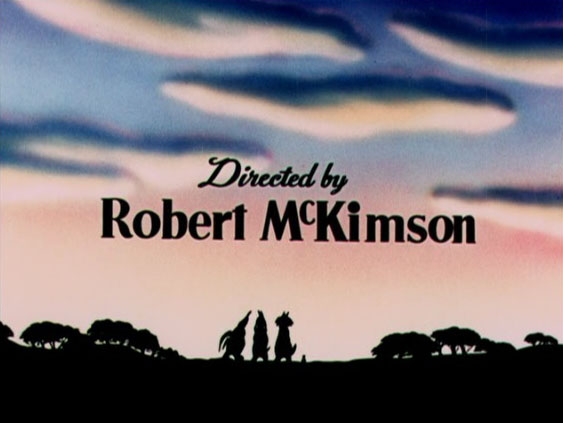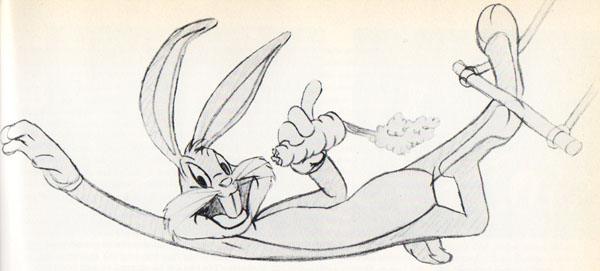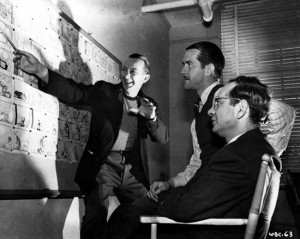
I’ve talked about animation legend Robert McKimson before at this site.
 McKimson was born in 1910 and passed away in 1977. He died from a massive heart attack while eating lunch with his friends Friz Freleng and David DePatie for whom he was working directing Pink Panther shorts among other things. Ironically, just days before the attack, he had visited the doctor for a complete physical and got a clean bill of health.
McKimson was born in 1910 and passed away in 1977. He died from a massive heart attack while eating lunch with his friends Friz Freleng and David DePatie for whom he was working directing Pink Panther shorts among other things. Ironically, just days before the attack, he had visited the doctor for a complete physical and got a clean bill of health.
He was best known for his work on Warner Brothers cartoons where he created Foghorn Leghorn, Tasmanian Devil and Hippety Hopper the kangaroo among others.
He worked as an animator and as a director. His 1942 model sheet for Bugs Bunny (and his promotional drawing of Bugs Bunny leaning against a tree while eating a carrot for a local Los Angeles store) set the design for the character for many years.
His two brothers, Charles and Tom, also worked as animators at Warner Brothers and later as comic book artists for Dell.
For the November 28, 1972 issue of PUNCH magazine, writer Lloyd Chester interviewed Bob McKimson on the state of animation.
The interview took place in McKimson’s Beverly Hills home in his den on a rainy morning. I dug this lost treasure out of my archives to share one of the rare times that McKimson talked about his own animation work in print:
“Bugs Bunny had only one meaning really—to make people happy, to get them to laugh at themselves.“There were so many of them. Sylvester, Tweety, Roadrunner, Coyote, Foghorn Leghorn and of course, the box-office champ of them all, Bugs Bunny!
“He was a fantastic character. Tex Avery is the man who gets most of the credit for creating him back in 1938. He got his name from Charles Thorsen who worked under the direction of another animator, ‘Bugs’ Hardaway. Thorsen drew some preliminary sketches and at the bottom of his drawings, he wrote Bugs’ Bunny and the name stuck.
“I gave him his face, that mobile, pixie look. I drew him so he could react to any situation, do anything most people would love to do, if they had the nerve. It was his character to be prankish, to take great delight in going up against every rule of society. He was brash and hated pretension but he was never malicious.
“I don’t think any cartoon character had the same impact as Bugs. He’s known the world over. You can walk down any street in London or Tokyo or Mexico City and stop the first person you meet and ask them if they know Bugs Bunny and they smile and reply ‘Of course we do’.
“During World War II, I personally drew over 150 Bugs Bunny insignias for different branches of the Armed Services and another time, during a Bond Rally, I drew a picture of Bugs for a lady for a donation of five thousand dollars.“He was great, but so were the others, too. They were all wonderful—Daffy Ducky, Yosemite Sam, Elmer Fudd, Porky Pig….
“Everyone could relate to our cartoons. People put themselves in the place of Bugs or Tweety, or Roadrunner doing all those crazy, zany things. It was great fun. I miss them all very much.
“We were a bunch of young guys in the middle of a Depression trying to bring a little happiness to a pretty sad world. We were looking for different things to do and as a result we experimented a lot. We had fun just walking up and down the halls at Warners wearing funny hats—all kinds: civil war caps, derbies, Stetsons, turbans—anything that we turn into a comedy situation.
“We thought funny. We were constantly telling ridiculous stories and jokes to each other and it paid off. Our mad-cap antics were reflected in our cartoons and when you look at ‘em today, hell, they’re still funny.
“Our story lines were carry-overs from the early days of Hollywood. Our cartoons were based on slapstick comedy…you know…the old pie-in-the-face, slap ‘em with a board, hit ‘em over the head schtick. We borrowed heavily from the masters—Chaplin, Turpin, Arbuckle, Laurel and Hardy. Whatever was good enough for them was certainly good enough for Bugs and Sylvester and the Coyote.
 “Mickey Mouse was the beginning and Bugs Bunny the turning point. Walt was the training ground for most of us old-timers and we worked on a lot of funny cartoons. Goofy was one and Donald Duck was another. Everyone in the industry tried to come as close as possible to Disney’s technique of full animation.
“Mickey Mouse was the beginning and Bugs Bunny the turning point. Walt was the training ground for most of us old-timers and we worked on a lot of funny cartoons. Goofy was one and Donald Duck was another. Everyone in the industry tried to come as close as possible to Disney’s technique of full animation.
“I recall one time Walt didn’t like the way the suspender buttons moved on Mickey’s trousers. I spent a full day working on those damn buttons until Walt was finally satisfied with their movement. He was a perfectionist and he taught most of us what we know about full animation. That was really our secret at Warners. None of our cartoon characters ever stood still.
“We live in a plastic age today. The new animators haven’t been trained in the art of full animation. They’ve been trained to do drawings and the drawings may look pretty but the action is stilted. They hold a character, move his mouth a little and then move him a little bit more. There is no action at all. They are mostly dialogue pictures and the more dialogue you have, the less action is needed. It’s cheaper to turn out. Cost is the big factor today. It’s expensive to make cartoons but then, all movie making is expensive today.
“I guess there will always be cartoons around, in one form or another. A friend of mine—he’s 72 years old—Ken Harris—he’s in England now teaching their young animators the technique of full animation. He’s one of the best around and originally I taught him, so I guess it does get passed on.
“But I don’t know…there’s only a handful of top animators left—they’re getting older or retiring or dying off…
“Say, did I ever tell you of the time I was in Japan and saw a Bugs Bunny cartoon? It was in Japanese and it sounded so funny to me but they love those characters over there and all over the world.”

pencil art from the title card of “Acrobatty Bunny”




 Jim Korkis is an internationally respected animation historian who in recent years has devoted his attention to the many worlds of Disney. He was a columnist for a variety of animation magazines. With his former writing partner, John Cawley, he authored several animation related books including The Encyclopedia of Cartoon Superstars, How to Create Animation, Cartoon Confidential and Get Animated’s Animation Art Buyer’s Guide. He taught animation classes at the Disney Institute in Florida as well as instructing classes on acting and animation history for Disney Feature Animation: Florida.
Jim Korkis is an internationally respected animation historian who in recent years has devoted his attention to the many worlds of Disney. He was a columnist for a variety of animation magazines. With his former writing partner, John Cawley, he authored several animation related books including The Encyclopedia of Cartoon Superstars, How to Create Animation, Cartoon Confidential and Get Animated’s Animation Art Buyer’s Guide. He taught animation classes at the Disney Institute in Florida as well as instructing classes on acting and animation history for Disney Feature Animation: Florida.




















































On YouTube there’s a animated short in Japanese featuring Bugs Bunny & Co that was released for the Warner Mycal Cinemas of Japan with the title card stating that it was a Warner Cinema production for the Warner International Cinemas dated from 2000 (even though the Roman numerals were “MCMLXXXXX” instead of “MM”.)
The Warner Brothers cartoon is indeed the top of the line, and I agree with every word Robert McKimson utters here. People of all ages laugh at LOONEY TUNES and MERRIE MELODIES because they are funny! Of course, in some cases, you have to understand movie history and, yes, the Warner Brothers cartoons have a long and colorful history! Cartoons in general had to laugh at the world around them, and yes, even today, there is a world around us that deserves to be poked and poked often! Bob McKimson was the man who lent the most life blood to the Warner Brothers characters. Just look at the body language of any of the characters; that is part of their humor and their identity. I’ve seen similar gags at other studios, but they don’t hit you in the funny bone as fast as the Warner Brothers cartoons. They may have learned some of their techniques under the direction of Walt Disney, but the characters themselves could only come from adults making cartoons for adults. They mocked everything you saw in live action at your local movie theater in the day, and that is what makes it all funny or interesting!
Robert McKimson is the least celebrated of the Warner Brothers directors. Chuck Jones, Friz Freleng, and Bob Clampett are more well known. They all did excellent cartoons, but McKimson created some great characters such as Foghorn Leghorn and The Tasmanian Devil and some of the funniest Bugs Bunny cartoons such as Hillbilly Hare.
McKimson’s stock has changed for the better though.
For so many years, he was The Lesser Director Who Was Better As An Animator. There is some truth in that… to a degree. His perfectionist draftsmanship skills were outstanding, but much of the humor in his films depended on who was working with him. He didn’t have a great teams-man ship like Chuck Jones had with Michael Maltese. No cartoon is the work of just one individual and McKimson seemed to struggle finding his “muse” with a proper partner. My only criticism of him is that certain animators like Rod Scribner were less flamboyant and more stagnated under him than with, say, somebody like Robert Clampett.
The bigger problem was that, heading the newer and less-pushed unit in the 1950s, his product showed all of the economic shortcuts expected with a declining animated shorts market several years before they happened with the Jones and Freleng units. Also some of his cartoons parodied TV shows of the period that we don’t recall today “unless we were there”. Often the characters resembled the Hanna-Barbera TV creations with less movement and more talk than action. Maybe it was because his 1940s work was VERY animated and plush that the downgrade from a zenith in the A HAM IN A ROLE years to the downright dull THE OILY AMERICAN period was a bit dramatic.
Curiously there has been a backlash against many animation historians’ “final word” (like Leonard Maltin, Mike Barrier and others) on McKimson, probably because he was too nice of a guy and his films were too under-appreciated by the High Brows. Sort of like the recent renewed interest in Republic Pictures thanks to more of them available online and it no longer being written off as a “B studio”. For ME, many of his films were less entertaining when I was younger, but have grown on me in a curious way. None of his Foghorn Leghorn films are bad… even a “turkey rooster” like THE SLICK CHICK has an oddball charm about it.
The only way I think he’s underrated is he never won an Oscar. Friz and Jones did.
Thank you for posting the article about my father to let others know about him and his accomplishments. His place in animation history needs more of this recognization.
Reading, The big thing I noticed was Bob used “we” and “our”, not “I” and “Me”, like in many of the Jones and Clampet interviews I’ve seen over the years.
To those who say McKimson’s Bugs was the “weakest” character, I can only ask, “By the way, how many lumps do you want?”